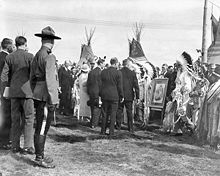- Nakoda (Stoney)
-
This article is about the Nakoda people of western Alberta, also called the Stoney. For several closely related peoples and languages, see Nakota.
 King George VI and Queen Elizabeth greet chieftains of the Stoney Indian Tribe, who have brought a photo of Queen Victoria, during the Royal Visit to Canada in 1939. The Treaties were originally signed by representatives of the British Crown acting in Queen Victoria's name.
King George VI and Queen Elizabeth greet chieftains of the Stoney Indian Tribe, who have brought a photo of Queen Victoria, during the Royal Visit to Canada in 1939. The Treaties were originally signed by representatives of the British Crown acting in Queen Victoria's name. Stoney Shield
Stoney Shield
The Nakoda (also known as Stoney or Îyârhe Nakoda) are a First Nation group, indigenous to both Canada and, originally, the United States.
They used to inhabit large parts of British Columbia, Alberta, Saskatchewan, and Montana,[1] but their reserves are now located in Alberta and in Saskatchewan where they are scarcely differentiated from the Assiniboine. Through their language they are related to the Dakota and Lakota nations of the Great Plains and the Rocky Mountains, part of the large Sioux Nation.[2]
They refer to themselves in their own language as "Nakoda", meaning friend, ally. The name "Stoney" was given them by white explorers, because of their technique of using fire-heated rocks to boil broth in rawhide bowls, also with vegetables. The vegetables just gave the soup more flavor. They are very closely related to the Assiniboine who are also known as Stone Sioux (from Ojibwe asinii-bwaan).
Alberta's Nakoda First Nation comprises three bands: Bearspaw, Chiniki and Wesley.[3]
Contents
Stoney groups
The Stoney are descendants of individual bands of Dakota, Lakota and Nakota, in particular of western groups of Assiniboine, from which they spun out as an independent group at about 1744. The Stoney were divided geographically and culturally into two tribal groups or divisions with different dialects, which in turn were further divided into several bands:[4][5]
Wood Stoney (Chan Tonga Nakoda- ‘Big Woods People’, often called Swampy Ground Assiniboine, northern tribal group)
- Alexis' band (Stoney, Métis, Woodland Cree)
- Paul's band (Danezaa, Stoney, Woodland Cree, Iroquois)
Mountain Stoney (Ye Xa Yabine Nakoda or Hebina - ‘Rock Mountain People’, often called Strong Wood Assiniboine, Thickwood Assiniboine, southern tribal group)
- Wesley's (Goodstoney's) band (Stoney, Plains Cree, Métis, Kutenai)
- Chiniki's band (Métis, Stoney, Plains Cree, Secwepemc, Kutenai)
- Bearspaw's band (Stoney, Cree)
- Sharphead's band (Chipos Ostikwan's Nakoda, Wolf Creek Stoney or Pigeon Lake Stoney, often called Plains Assiniboine) (Stoney, Métis)
Treaties
Members of the Nakoda nations of Paul and Alexis signed an adhesion to Treaty 6 in 1877.
In 1877, representatives of the Nakoda Nations of Bearspaw, Chiniki and Wesley met with representatives of the British Crown to discuss the terms of Treaty 7.[6] In exchange for use of traditional native lands, the Crown agreed to honor their right to self-government and an ancestral way of life. They were also promised reserve lands, 279 km² situated along the Bow River between the Kananaskis River and the Ghost River, which became the Big Horn, Stoney and Eden Valley reserves, shared between the Bearspaw, Chiniki and Wesley tribes.
See also
- Sioux language
- Nakota
- First Nations in Alberta
- List of Alberta Indian reserves
- stoney first nation culture
References
- ^ "Stoney Nation: Our History". Stoney Nation Website. Stoney Nation. http://www.stoneynation.com/ourhistory.html. Retrieved 2009-06-12.[dead link]
- ^ v. article Nakota
- ^ "Bearspaw, Chiniki, Wesley Nakoda Nations (Stoney)". Treaty 7 Management Corporation. http://www.treaty7.org/BearspawChinikiWesleyNakodaNations.aspx. Retrieved 2009-06-12.
- ^ Raymond DeMallie,William Sturtevant: Handbook of North American Indians: Plains, ISBN 978-0-16-050400-6, pp 596 - 603
- ^ Northwest Plains History
- ^ "Articles of Treaty No. 7". Treaty 7 Management Corporation. http://www.treaty7.org/ArticlesofTreatyNo7.aspx. Retrieved 2009-06-12.
First Nations in Alberta Cultural areas Plains · SubarticNumbered Treaties Ethno-cultural groups and languages Beaver / Daneẕaa (language) · Blackfoot / Niitsítapi (language) · Chipewyan / Denésoliné (language) · Cree / Nēhilawē (Woodland Cree) (language [plains variant]) · Sarcee / Tsuu T'ina (language) · Saulteaux / Nakawē (language) · Stoney / Nakoda (language)
First Nation
governments (bands)Alexander · Alexis · Athabasca Chipewyan · Bearspaw · Beaver · Beaver Lake Cree · Bigstone Cree · Chiniki · Chipewyan Prairie · Cold Lake · Dene Tha' · Driftpile · Duncan's · Enoch Cree · Ermineskin Cree · Fort McKay · Fort McMurray · Frog Lake · Heart Lake · Horse Lake · Kainai · Kapawe'no · Kehewin Cree · Little Red River Cree · Loon River · Louis Bull · Lubicon Lake · Mikisew Cree · Montana · O'Chiese · Paul · Piikani · Saddle Lake · Samson Cree · Sawridge · Siksika · Smith's Landing · Sturgeon Lake · Sucker Creek · Sunchild · Swan River · Tallcree · Tsuu T'ina · Wesley · Whitefish Lake (Atikameg) · Whitefish Lake (Goodfish) · Woodland CreeList of Alberta Indian reserves · Métis in Alberta 
This First Nations-related article is a stub. You can help Wikipedia by expanding it.

